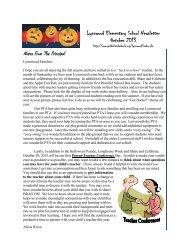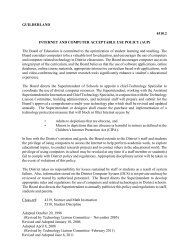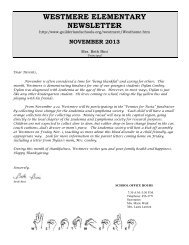Printable Copy of the Field Study Guide (PDF)
Printable Copy of the Field Study Guide (PDF)
Printable Copy of the Field Study Guide (PDF)
You also want an ePaper? Increase the reach of your titles
YUMPU automatically turns print PDFs into web optimized ePapers that Google loves.
Station #4: Pot holes / Pr<strong>of</strong>iles / Groundwater<br />
At this location on <strong>the</strong> field trip, students observe potholes that have been carved<br />
in <strong>the</strong> streambed by <strong>the</strong> action <strong>of</strong> moving water. Begin by viewing <strong>the</strong> pothole picture<br />
show. The first picture is a view <strong>of</strong> station 4 with potholes visible in <strong>the</strong> streambed as we<br />
approach it from downstream. Pictures 2, 3, 4, and 5 are close ups <strong>of</strong> <strong>the</strong> potholes.<br />
Water running downstream provides enough force to begin a whirling motion <strong>of</strong><br />
rock fragments that fall into a small depression. As <strong>the</strong> rock fragments are swirled and<br />
bump into each o<strong>the</strong>r, <strong>the</strong>y carve <strong>the</strong> bedrock <strong>of</strong> <strong>the</strong> streambed, making <strong>the</strong> depression<br />
deeper and larger. If you look carefully through <strong>the</strong> glare <strong>of</strong> picture 5 in <strong>the</strong> above link,<br />
you can see <strong>the</strong> rock fragments (called scouring stones) presently caught in <strong>the</strong> pothole.<br />
New rock fragments tumble into <strong>the</strong> pothole as older ones move on or are worn away,<br />
enabling <strong>the</strong> grinding process to continue. At this location, <strong>the</strong> water is only flowing fast<br />
enough for <strong>the</strong> scouring stones to be swirled when <strong>the</strong> water in <strong>the</strong> stream is very high.<br />
In <strong>the</strong> pictures, <strong>the</strong> stream is not moving fast enough for pothole formation to be taking<br />
place.<br />
Pothole Activities<br />
These activities attempt to mimic <strong>the</strong> process <strong>of</strong> pothole formation:<br />
1) a) In <strong>the</strong> lower margin <strong>of</strong> this page, move your pen around in a 1/4" diameter circle<br />
for 1 minute and describe what happens below:<br />
How many layers <strong>of</strong> paper did your pen tear through?<br />
b) Get two pieces <strong>of</strong> rock – one pebble and one cobble. This time rub <strong>the</strong> pebble in<br />
a small circle on <strong>the</strong> cobble for 1 minute. Describe <strong>the</strong> results below:<br />
Water Sources at this station Examine picture 6 in <strong>the</strong> pothole picture show. In this<br />
picture <strong>the</strong> stream is seen in <strong>the</strong> foreground. If you look at <strong>the</strong> far side <strong>of</strong> <strong>the</strong> stream<br />
<strong>the</strong>re is a tree with a hollow at its base near <strong>the</strong> center <strong>of</strong> <strong>the</strong> photo. Look carefully and<br />
you will see that water from an underground stream flows onto <strong>the</strong> surface from this<br />
small cave.<br />
Looking at picture 6 estimate <strong>the</strong> percentage <strong>of</strong> water entering <strong>the</strong> stream from <strong>the</strong><br />
spring.
















